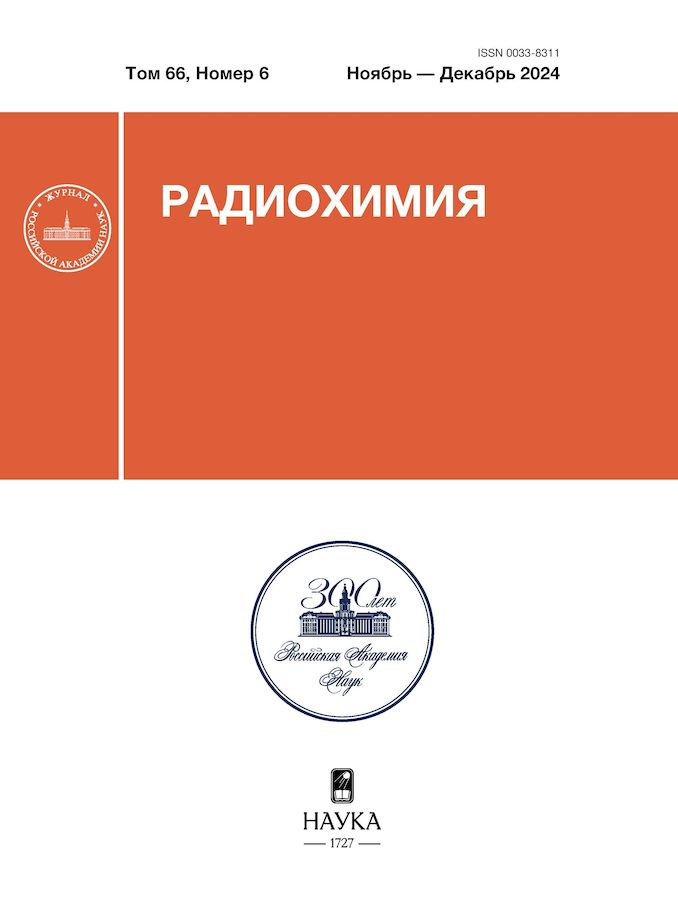High-entropy melt of lithium, sodium, and potassium fluorides and chlorides as a possible coolant for molten-salt reactors
- 作者: Zakiryanov D.O.1, Tkachev N.K.2
-
隶属关系:
- Institute of High-Temperature Electrochemistry, Ural Branch, RAS
- Institute of Metallurgy, Ural Branch, RAS
- 期: 卷 66, 编号 6 (2024)
- 页面: 538-542
- 栏目: Articles
- URL: https://gynecology.orscience.ru/0033-8311/article/view/681266
- DOI: https://doi.org/10.31857/S0033831124060037
- ID: 681266
如何引用文章
详细
Suggestions are made for potentially promising solvent melts for molten salt reactors from a mixture of six lithium, sodium, and potassium fluoride and chloride salts having high entropy of mixing. These compositions, containing less lithium salts, should have higher thermodynamic stability than FLiNaK or FLiBe because of their high entropy. The chemical formula of the maximum high-entropy solution, Li1/6Na1/6K1/6F1/4Cl1/4, may result from mixing the variety of alkali halides like MX (M = Li, Na, K and X = F, Cl) taken in an equimolar ratio. Molecular dynamic estimations of the density, heat conductivity, and viscosity demonstrate reasonable values of these properties between those of the fluorides and chlorides.
全文:
作者简介
D. Zakiryanov
Institute of High-Temperature Electrochemistry, Ural Branch, RAS
编辑信件的主要联系方式.
Email: N.K.Tkachev@gmail.com
俄罗斯联邦, Yekaterinburg
N. Tkachev
Institute of Metallurgy, Ural Branch, RAS
Email: N.K.Tkachev@gmail.com
俄罗斯联邦, Yekaterinburg
参考
- Le Brun C. // J. Nucl. Mater. 2007. Vol. 360. P. 1–5. https://doi.org/10.1016/j.jnucmat.2006.08.017
- Molten Salt Reactors and Thorium Energy / Eds T.J. Dolan, I. Pazsit, A. Rykhlevskii, R. Yoshioka, Elsevier, 2023. https://doi.org/10.1016/C2021-0-01689-8
- Krepel J., Dietz J., De Oliveira R. Characterization of the molten chloride fast reactor fuel cycle options, Int. Conf. Fast Reactors and Related Fuel Cycles FR22: Sustainable Clean Energy for the Future (CN-291), Vienna, 2022. https://conferences.iaea.org/event/218/contributions/19007/
- Bessada C. From fluorides to chlorides in nuclear energy detection of anionic complexes by NMR, EXAFS and MD at high temperature, EUCHEM Conf., Spain: MSIL, 2024.
- Sangster J.S., Pelton A. // J. Phys. Chem. Ref. Data. 1987. Vol. 16. N 3. P. 509–561.
- Пригожин И.Р., Дэфей Р. Химическая термодинамика. Новосибирск: Наука, 1966. 509 с.
- Cantor B. // Prog. Mater. Sci. 2021. Vol. 120. ID 100754. https://doi.org/10.1016/j.pmatsci.2020.100754
- Блинкин В.Л., Новиков В.М. Жидкосолевые ядерные реакторы. М.: Атомиздат, 1978. 112 c.
- Tkachev N. Three compositions of high-entropy melts of lithium, sodium and potassium fluorides and chlorides as promising coolants for molten salt reactors // ChemRXiv. 2024. https://doi.org/10.26434/chemrxiv-2024-b6j96
- Диаграммы плавкости солевых систем. Многокомпонентные системы / Под. ред. В.И. Посыпайко, Е.А. Алексеевой. М.: Химия, 1977. С. 165.
- Бергман А.Г., Березина С.И., Бакумская Е.А. // ЖНХ. 1963. Т. 8. С. 2144.
- Zakiryanov D.O., Kobelev M.A., Tkachev N.K. // Fluid Phase Equil. 2020. Vol. 506. ID 112369. https://doi.org/10.1016/j.fluid.2019.112369
- Минченко В.И., Степанов В.П. Ионные расплавы: упругие и калорические свойства. Екатеринбург: ИВТЭ УрО РАН, 2008.
- Salanne M., Simon C., Turq P., Madden P.A. // J. Fluorine Chem. 2009. Vol. 130. P. 38–44. https://doi.org/10.1016/j.jfluchem.2008.07.013
- Ingersoll D.T., Forsberg C.W., MacDonald P.E. Trade Studies for the Liquid-Salt-Cooled Very High-Temperature Reactor: Fiscal Year 2006 Progress Report. Oak Ridge, Tennessee: Oak Ridge National Laboratory, 2007.
- An X.-H., Cheng J.-H., Su T., Zhang P. // AIP Conf. Proc. 2017. Vol. 1850. ID 070001. https://doi.org/10.1063/1.4984415
- Janz G.J., Tomkins R.P.T. Physical Properties Data Compilations Relevant to Energy Storage: IV Molten Salts: Data on Additional Single and Multi-Component Salt Systems, National Standard Reference Data System, National Bureau of Standards Report NSRDS-NBS 61, 1981. Part IV.
- Rudenko A., Kataev A., Tkacheva O. // Materials. 2022. Vol. 15. ID 4884. https://doi.org/10.3390/ma15144884
- Nguyen D.K., Danek V. Chem. Papers. 2000. Vol. 54. N 5. P. 277–281.
- Wang J., Liu C.-L. // J. Mol. Liq. 2019. Vol. 273. P. 447–454. https://doi.org/10.1016/j.molliq.2018.10.062
- Zakiryanov D.O., Tkachev N.K. // Int. J. Heat Mass Transfer. 2021. Vol. 181. ID 121863. https://doi.org/10.1016/j.ijheatmasstransfer.2021.121863
- Gallagher R.C., Birri A., Russell N.G., Phan A.-T., Gheribi A.E. // J. Mol. Liq. 2022. Vol. 361. ID 119151. https://doi.org/10.1016/j.molliq.2022.119151
- An X.-H., Cheng J.-H., Su T., Zhang P. // AIP Conf. Proc. 2017. Vol. 1850. ID 070001. https://doi.org/10.1063/1.4984415
- Nagasaka Y., Nakazawa N., Nagashima A. // Int. J. Thermophys. 1992. Vol. 13. P. 555–574. https://doi.org/10.1007/bf00501941 https://en.wikipedia.org/wiki/Molten-salt_reactor
- Capelli E., Konings R.J.M. // Comprehensive Nuclear Materials. 2020. 2nd Ed. Vol. 7. P. 256–283. https://doi.org/10.1016/B978-0-12-803581-8.11794-1
- Yingling J.A., Schorne-Pinto J., Aziziha M., Ard J.C., Mofrad A.M., Christian S., et al. // J. Chem. Thermodyn. 2023. Vol. 179. ID 106974. https://doi.org/10.1016/j.jct.2022.106974
- Smith A.L. // J. Mol. Liq. 2022. Vol. 360. ID 119426. https://doi.org/10.1016/j.molliq.2022.119426
补充文件











